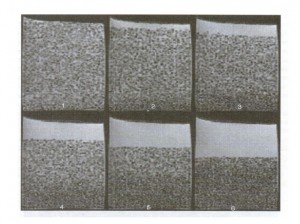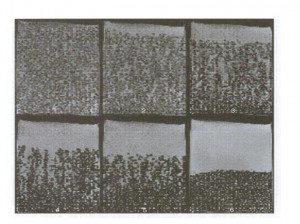When suspensions sediment through viscoelastic fluids, a structural instability occurs in which the particles order themselves into particle-rich and particle-depleted regions. This change causes a dramatic change in the rate of sedimentation, and is expected to have a comparable effect on the rate of creaming in emulsions. Shown below are images of particles sedimenting 1) through a polyacrylamide solution (above) and 2) through a Newtonian fluid (below). In the Newtonian fluid, the microstructure remains homogeneous and the sedimentation rate is constant. In the viscoelastic fluid, columns form and the sedimentation rate varies continuously. These images were obtained by magnetic resonance imaging (MRI), and are published in the paper by Bobroff and Phillips (1998). Similar behavior has been seen in sedimentation through Xanthan solutions (cf. Mora, Talini and Allain, Phys. Rev. Lett. 95:088301, 2005)


